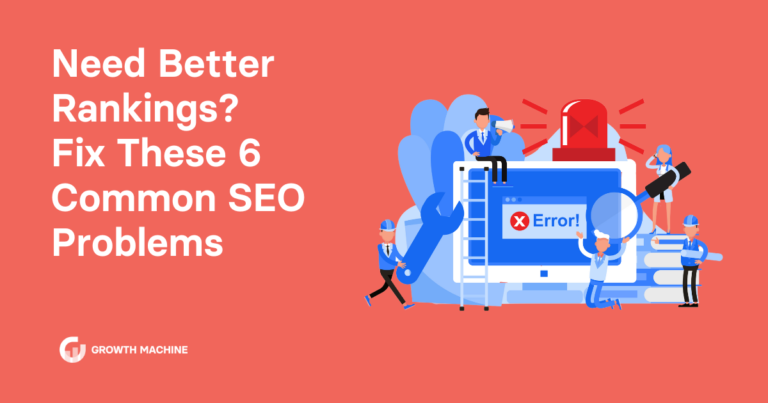How Long Does It Take to Rank on Google?
“When will we see SEO results?”
We get this question all the time from clients and prospects — and rightly so. It is, after all, the million-dollar question in content marketing. We tell clients upfront when we start working with them that SEO (search engine optimization) is an investment that requires time and patience to build momentum, but when it pays off, it’ll be well worth it. So naturally, the next question is, “Well, how long do we need to be patient?”
We’ve discussed the Critical Authority Threshold before, but the time it takes to reach that point varies from client to client and industry to industry. We’ve seen clients start to hit their traffic tipping point — where Google begins to trust your site’s authority and your site’s rankings and traffic improve exponentially – in just about four months, and I’ve seen others take nine to 12 months. Fortunately (or unfortunately, depending on how you look at it) this is all completely normal!
On average, we start to see a significant uptick in the growth rate of traffic around six months, but this is based on many assumptions and considerations, the most important of which we’ll walk you through here. Let’s get started.
7 Factors That Affect How Long It Takes a Site to Rank on Google
If you think about these seven factors as you set up your blog and publish your content, you’ll be in great shape to maximize your site’s ranking potential!
1. The Index Status and Architecture of Your Site
Did you know that the technical setup of your website is one of the most important ranking factors Google looks for, and can make or break your site’s likelihood of making it to the first page of Google search results?
That’s right: Google’s algorithm takes into account several aspects of your site you might not expect — like average time on page, site loading time, and how quickly someone leaves your site to go back to the results page — that Google has decided are direct or indirect indicators of how effective and authoritative your content is.
You wouldn’t believe how often we see a site that we know should be ranking well and picking up lots of new traffic, but just … isn’t. After we dig and dig, we find the problem. It could be that something’s off about the site architecture, or the redirections are poorly set up, or there’s a glitch in the way the main site is linked to the blog.
To start ranking, these basics must be in place:
- Your site architecture is clean and simple
- Your sitemap is up to date and, ideally, submitted to Google
- Redirections are set up properly
- Your blog is linked from the homepage
Make sure you’re thinking through the basic architecture of your site before you engage in content production, or else you may be wasting your time. Is your blog live? Can we start publishing immediately? Does Google know it exists? Is it easy for Google to crawl your site with little to no confusion?
The most efficient way to start a successful content engagement is to make sure your new website is built on a solid foundation and maintained by a technical team you trust!
If you have a site already, you can use a tool like Ahrefs, Moz, or Screaming Frog to check the technical health of your site periodically. Making sure there are no technical hindrances is one of the most important (and easiest) ways to improve your position in the SERPs (search engine results page).
Once you’ve ensured that your site is technically sound with no major errors, you can examine the other major factors that impact your ranking and traffic timeline.
2. Your Domain Authority
Domain authority or domain rating (abbreviated as DA or DR) is an estimated measure of the level of credibility your site has on its subject matter in the eyes of Google.
Lots of factors influence your domain authority, and no one knows the precise equation. But we do know that backlink profile, (sometimes) domain age, and the success of existing content all factor heavily into your domain authority. You can loosely think of this to mean that the more your existing content ranks, the more your future content will (and the faster it’ll happen).
So a brand-new site with a URL you just purchased and nothing more than a landing page will take awhile to rank. On the other hand, a long-established website with many pages of rich content like a home page, about page, product pages, a large and diverse backlink profile, and maybe even an existing blog will tend to rank new content faster.
This is why we encourage clients who are launching new sites to bank a backlog of content before they officially launch the site, so that the site looks richer and more authoritative from day 1 in the eyes of Google.
This is also why we make a few other recommendations that are geared at building domain authority, such as encouraging clients to:
- Establish their blog as a subfolder (site. com/blog) rather than a subdomain (blog.site. com). This way, authority from the existing site is conferred onto the blog, which helps the blog content rank faster.
- Start with lower-competition keywords, even if they’re lower volume, and not the client’s first priority. Lower-competition keywords rank faster, and rankings build domain authority.
- Stick to a strict publishing schedule (more on that in a second).
3. What Category You’re In
Cup & Leaf started as an experiment to see how quickly we could get to 150,000 visitors in a space that was relatively untapped. This site was a great example of how quickly you can make SEO headway in a category with rich keyword opportunities where there aren’t a lot of competitors publishing search-focused, optimized content.
Unfortunately, there aren’t a lot of categories like this left! Sometimes our clients luck out, but more often than not, they’re in moderately to extremely competitive categories where a number of other content creators have a big head start. Some of those competitors may be extremely high-authority sites that are targeting the same or similar keywords.
If you’re a lower-authority site competing in a saturated category with higher-authority sites, it’ll likely take longer to start seeing first-page rankings. That said, the old adage “better late than never” still applies.
4. Your Keyword Strategy
It should come as no surprise that the heart of every successful SEO strategy is thoughtful, relevant keyword research.
When you have a content plan full of low-competition keywords with a high search volume — meaning lots of people are searching for the word or phrase, but not a lot of results are tailored to answer the query — you’re in a good position to rank quickly. That’s exactly what happened to us when we launched Cup & Leaf, and how we were able to reach some impressive ranking positions more quickly than average.
Even if you’re in a more competitive space than the tea category, the more you stick to target keywords with a lot of organic traffic but relatively low competition — we consider anything <30 difficulty on Ahrefs to be a reasonably accessible keyword — the more quickly you’ll see SEO rankings.
But your success and Google ranking speed will be dependent on more than just going after low-difficulty and high-volume keywords. By now, it should go without saying, but all the same: Those keywords have to be relevant to your site and you (or your writer) has to have the authority to be writing about the subject.
If you’re a nut butter company, you’re very unlikely to rank for an article about heart health, regardless of how low the difficulty and high the keyword search volume is. Spending the time to do thoughtful, in-depth keyword research to uncover relevant keywords and phrases that your competitors aren’t going after, but your consumer is thinking about, is a surefire strategy for reaching a top ranking position more quickly.
5. Your Post Frequency
The more high-quality content you publish each week, the faster Google is likely to recognize that your site is well-established, reliable, and trustworthy in its niche. Although posting frequency isn’t the only way to reach the Critical Authority Threshold faster, it does speed up the process.
Let’s assume that Google needs to see 60-72 high-quality articles on a topic before it’s willing to consider a site an authority on that topic and give the site some first-page rankings. This isn’t a hard-and-fast rule, but it’s an average that we’ve observed across dozens of clients and categories.
If you’re publishing three articles per week every week, it will take about six months to reach that point where Google starts to trust your site and you’ll see exponential growth. If you’re publishing two articles per week, it will take at least seven to eight months, and if you’re publishing one article per week, it could take over a year.
That doesn’t mean it’s not worth it to invest in content if all you can afford is one to two articles per week. It just means that you’ll need to adjust your expectations and have a deeper well of patience while you wait to see it pay off.
6. Your Post Quality
“Just write great content and you’ll see higher rankings!” Well, sure, but that’s easier said than done, right?
Google judges the quality of posts on a few factors, each of which has an impact on ranking potential. First, the post has to be relevant to the theme of your site and the topic that you’re trying to establish your site’s authority on. It needs to be clearly written and include specific, actionable information to help the searcher solve their problem or answer their question.
Next, your site benefits from EAT. No, we don’t mean your lunch (sorry, couldn’t resist!). EAT is an acronym that stands for Expertise, Authoritativeness, and Trustworthiness. Expertise means that your content must be written by someone with the knowledge to reliably share the information. For example, health content must be written by a medical professional. Authoritativeness means that the content creator should be established and recognizable in some way as an expert in the topic. And Trustworthiness means that the author is reliable and free of potential scandal or conflict of interest.
These three quality indicators apply to some degree to all content, but are especially relevant to content that relates to health, wellness, or financial content (including all e-commerce sites that sell goods and services!) — topics Google has deemed especially impactful to people’s lives. Therefore, it weighs EAT more heavily when it comes to content or websites that address these topics.
For more detailed information about EAT and content quality, check out this article from Semrush.
Finally, Google judges the quality of your content — and your site as a whole — based on your backlink profile. Backlinks are all of the links back to your site (see what they did there?) from other sites around the internet. As you know, Google assumes some degree of authority from every site, so when high-authority sites reference your content by linking to it, Google assumes your content, and website, must be authoritative and trustworthy as well. That’s why quality content is the foundation of a successful link building strategy.
7. Your Publishing Consistency
Publishing consistency is exactly what it sounds like: Are you pushing out three articles per week, every week, on (mostly) the same days? Or are you ignoring your blog for three weeks, then publishing 10-15 articles on the same day at the end of the three weeks?
It may seem like a trivial difference to you — after all, 15 articles is 15 articles, right? — but it matters to Google. A consistent, predictable schedule of high-quality articles helps to reinforce the message to Google that your site is well-run by experts who are reliably dedicated to providing resources to searchers. That’s the kind of site Google wants to reward with strong rankings.
The site that dumps large amounts of content at once after a prolonged absence is inadvertently telling Google that it’s de-prioritizing content and providing a less-valuable experience for site users. Yes, even if the content is exactly the same level of quality.
At the end of the day, Google wants to provide the best user experience by directing its search traffic to a site that invests in publishing valuable resources that will answer their questions thoroughly and consistently. That’s a win for Google, a win for the searcher, and a win for the site.
SEO Success Is Waiting For You
Although SEO success can feel daunting, keeping in mind these seven simple tips will put you on the road to rankings. We have dozens of successful client sites to prove it!
At Growth Machine, we’ve helped companies of all sizes go from 0-100,000 monthly visitors in six months and quadruple their traffic in a mere three months. To learn how Growth Machine can help increase traffic for your website, contact us for a free consultation.




![How to Build a Digital Content Strategy: Step-by-Step Guide [2023]](https://www.growthmachine.com/wp-content/uploads/2024/06/How-to-Build-a-Digital-Content-Strategy-Step-by-Step-Guide-2023-768x403.png)


